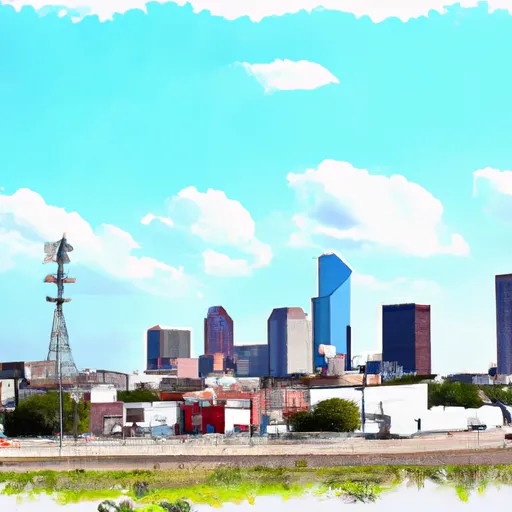-
 Snoflo Premium
Snoflo Premium
Get unlimited access to all our content
With no Ad interruptions! - Start Your Free Trial Login with existing account
Uhland
Eden Index
Climate
8.2
•
Recreation
3.4
•
Community
3.5
•
Safeguard
5.3/10

Uhland, Texas is a small town located in Hays County, approximately 25 miles south of Austin. The climate in Uhland is classified as humid subtropical, characterized by hot summers and mild winters. Average high temperatures in the summer months range from the mid-90s to low 100s Fahrenheit, while winter highs typically reach the mid-60s. Precipitation is fairly evenly distributed throughout the year, with an annual average of around 36 inches.
Hydrologically, Uhland is situated in the Plum Creek watershed, contributing to the Blanco River. The water in this area consists of various constituents, including dissolved minerals and organic matter, which can impact the water quality and aquatic ecosystem.
Outdoor recreation opportunities in Uhland and its surrounding areas are abundant. The nearby Plum Creek Preserve offers opportunities for hiking, birdwatching, and nature exploration. Additionally, the Blanco River provides opportunities for fishing, canoeing, and kayaking. Nature enthusiasts can also explore nearby state parks such as McKinney Falls State Park and Lockhart State Park, which offer camping, hiking trails, and picnicking spots. With its diverse natural landscapes and proximity to larger cities like Austin, Uhland provides ample opportunities for residents and visitors to enjoy the outdoors.
What is the Eden Index?
The Snoflo Eden Index serves as a comprehensive rating system for regions, evaluating their desirability through a holistic assessment of climate health, outdoor recreation opportunities, and natural disaster risk, acknowledging the profound impact of these factors on livability and well-being.
Climate Health Indicator (CHI): 8.2
Uhland receives approximately
876mm of rain per year,
with humidity levels near 89%
and air temperatures averaging around
20°C.
Uhland has a plant hardyness factor of
8, meaning
plants and agriculture in this region tend to thrive here all year round.
By considering the ideal temperature range, reliable water supplies, clean air, and stable seasonal rain or snowpacks, the Climate Health Indicator (CHI) underscores the significance of a healthy climate as the foundation for quality living.
A healthy climate is paramount for ensuring a high quality of life and livability in a region, fostering both physical well-being and environmental harmony. This can be characterized by ideal temperatures, reliable access to water supplies, clean air, and consistent seasonal rain or snowpacks.
Weather Forecast
Streamflow Conditions
Guadalupe
Area Rivers
Guadalupe
Snowpack Depths
Guadalupe
Reservoir Storage Capacity
Guadalupe
Groundwater Levels
Recreational Opportunity Index (ROI): 3.4
The Recreational Opportunity Index (ROI) recognizes the value of outdoor recreational options, such as parks, hiking trails, camping sites, and fishing spots, while acknowledging that climate plays a pivotal role in ensuring the comfort and consistency of these experiences.
Access to outdoor recreational opportunities, encompassing activities such as parks, hiking, camping, and fishing, is crucial for overall well-being, and the climate plays a pivotal role in enabling and enhancing these experiences, ensuring that individuals can engage in nature-based activities comfortably and consistently.
Camping Areas
| Campground | Campsites | Reservations | Toilets | Showers | Elevation |
|---|---|---|---|---|---|
| Pace Bend Park - Lake Travis | 420 | 781 ft | |||
| Berry Springs Park and Preserve | None | 673 ft | |||
| Jim Hogg - Lake Georgetown | None | 880 ft | |||
| Emma Long Metropolitan Park | 60 | 499 ft | |||
| Cedar Breaks - Lake Georgetown | None | 841 ft | |||
| Lockhart State Park | 20 | 499 ft | |||
| Arkansas Bend - Lake Travis | None | 724 ft | |||
| Cypress Creek - Lake Travis | None | 804 ft | |||
| McKinney Falls State Park | 89 | 571 ft | |||
| Camp Mabry Military | None | 654 ft |
Nearby Fishing
Nearby Ski Areas
Catastrophe Safeguard Index (CSI):
The Catastrophe Safeguard Index (CSI) recognizes that natural disaster risk, encompassing floods, fires, hurricanes, and tornadoes, can drastically affect safety and the overall appeal of an area.
The level of natural disaster risk in a region significantly affects safety and the overall livability, with climate change amplifying these risks by potentially increasing the frequency and intensity of events like floods, fires, hurricanes, and tornadoes, thereby posing substantial challenges to community resilience and well-being.
Community Resilience Indicator (CRI): 3.5
The Community Resilience Indicator (CRI) recognizes that education, healthcare, and socioeconomics are crucial to the well-being of a region. The CRI acknowledges the profound impact of these elements on residents' overall quality of life. By evaluating educational resources, healthcare accessibility, and economic inclusivity, the index captures the essential aspects that contribute to a thriving community, fostering resident satisfaction, equity, and social cohesion.

